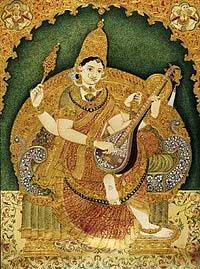Mysore Painting is a traditional South Indian painting style that has roots in the Vijayanagara Empire. It flourished mainly in Mysore, Karnataka. Known for its elegance and rich colors, this art form beautifully blends artistic and cultural heritage.

Source: https://en.wikipedia.org/wiki/Mysore_painting
A Historical Perspective Mysore paintings
This paintings evolved during the Wodeyar dynasty, which ruled from the late 14th to the mid-20th century. Influenced by Vijayanagara murals, these paintings often depict Hindu mythology. The Wodeyars were great patrons of the arts, allowing artists to experiment and create unique styles.
Artistic Characteristics about Mysore Hand Painting
These paintings feature delicate lines and intricate details. Artists use fine brushes made from squirrel hair for precision. The color palette is muted, using earthy tones from natural sources. Gold leaf is often used to highlight elements, adding a luxurious touch. The themes are mainly religious, featuring deities and epic scenes.
The Process of Mysore Hand Paintings
Creating a painting involves several meticulous stages. First, the base of paper or cloth is prepared with zinc oxide and Arabic gum. The artist sketches the design outline next. Natural pigments are used to fill in the colors. Finally, gold leaf is applied with a steady hand. Each painting can take weeks or even months to complete.
Preservation and Contemporary Relevance
Interest in Mysore art has resurged recently. Efforts by art historians, cultural organizations, and dedicated artists help preserve this tradition. Workshops and exhibitions educate people about its history and techniques. Contemporary artists experiment with modern themes, ensuring the art form evolves and remains relevant.
FAQ
What materials are used in Mysore art?
Natural pigments from minerals and plants, along with gold leaf, are used. The base is typically paper or cloth prepared with zinc oxide and Arabic gum.
How are Mysore hand paintings different from Tanjore paintings?
This paintings have delicate lines and muted colors. Tanjore paintings feature rich, vibrant colors and extensive gold foil.
How can one ensure the longevity of a Mysore art painting?
Keep the painting away from direct sunlight and moisture. Framing with protective glass helps preserve its details and colors.
Also view other Indian art form
- Madhubani Painting: Also called Mithila Painting. Vibrant folk art from Bihar, known for intricate patterns and storytelling.
- Warli Art: Tribal art form from Maharashtra, characterized by simplistic yet expressive depictions of daily life.
- Tanjore Painting: Classical South Indian art form renowned for its rich use of gold foil and vibrant colors.
- Kalamkari Painting: Ancient art form from Andhra Pradesh, using natural dyes and intricate storytelling on cloth.
- Mughal Painting: Detailed miniature paintings from the Mughal era, showcasing courtly scenes and historical events.
- Pattachitra Painting: Traditional art form from Odisha, featuring bold lines, vibrant colors, and mythological themes.
- Gond Painting: Tribal art form from Madhya Pradesh, celebrated for its vibrant colors and intricate patterns inspired by nature.
- Rajasthani Miniature Painting: Diverse styles of miniature paintings from Rajasthan, depicting courtly life, landscapes, and religious themes.
- Kerala Mural Painting: Elaborate and colorful murals found in Kerala’s temples and palaces, showcasing Hindu mythology and folklore.
- Thangka Painting: Tibetan Buddhist art form practiced in parts of India, revered for its spiritual significance and intricate details.
- Kangra Painting: Miniature painting style from Himachal Pradesh, known for its romantic themes and delicate brushwork.
- Pichwai Painting: Devotional art form from Rajasthan, depicting Lord Krishna and his various leelas.
- Kalighat Painting: Folk art from Bengal, characterized by simple lines, bold colors, and depictions of everyday life and deities.
